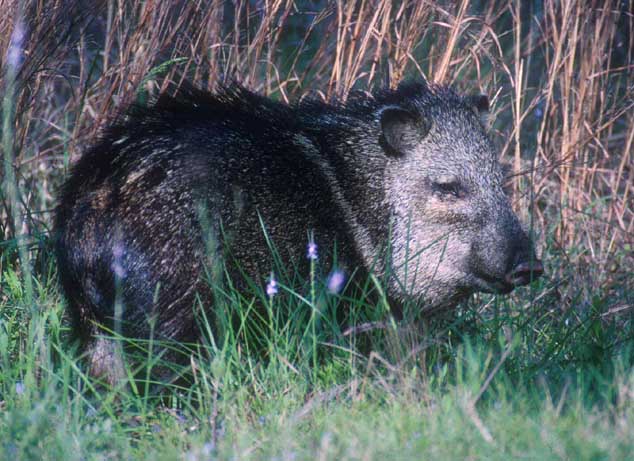

Peccaries are omnivorous but generally prefer roots, seeds, and fruit. In desert country they eat a lot of cacti. Unlike pigs which are generally solitary except mothers raising young, peccaries live in herds. Collared Peccary groups usually consist of 15-50 individuals. White-lipped Peccaries often have gangs of over a hundred, but the Chacoan Peccary has small groups of 2-10. Herds will break up in the dry season if food is hard to find.
Stumbling across a herd of peccaries in the rain forest can be an impressive experience. A dozen Collard Peccaries that trampled past me in the remote rainforest along the Rio Cristalino in central Brazil were (fortunately) unaware of my presence as I stood stock still. Their grunts and hoofbeats sounded like a horde of giant alien locusts devouring the forest. Groups of Collared Peccary apparently have no leader, but when moving from one feeding site to another they follow whichever individual happens to be at the front of the line, usually one of the adult females.
The main predators of peccaries are mountain lions and jaguars. Macdonald (1984) tells this story:
"South American peasants claim 'that the jaguar only kills peccaries that remain apart from the group.' This saying has been verified, since it is now known that individual peccaries will confront a predator, at considerable risk to themselves, while other members of their group escape. Such altruistic anti-predator behavior is just one of the unusual features of the life-style of peccaries."Literature: The taxonomy here follows Macdonald, D., ed. (1984) The Encyclopedia of Mammals, 1st ed. Facts on File Publ., New York. Other than personal experiences, the facts are mostly summarized from that text.
PHOTOS: All photos on this page are © 2002 by W. Ed Harper, used with permission; all rights reserved. The Javelina (Collared Peccary) was photographed in Aransas NWR, Texas, on 12 Apr 1995.